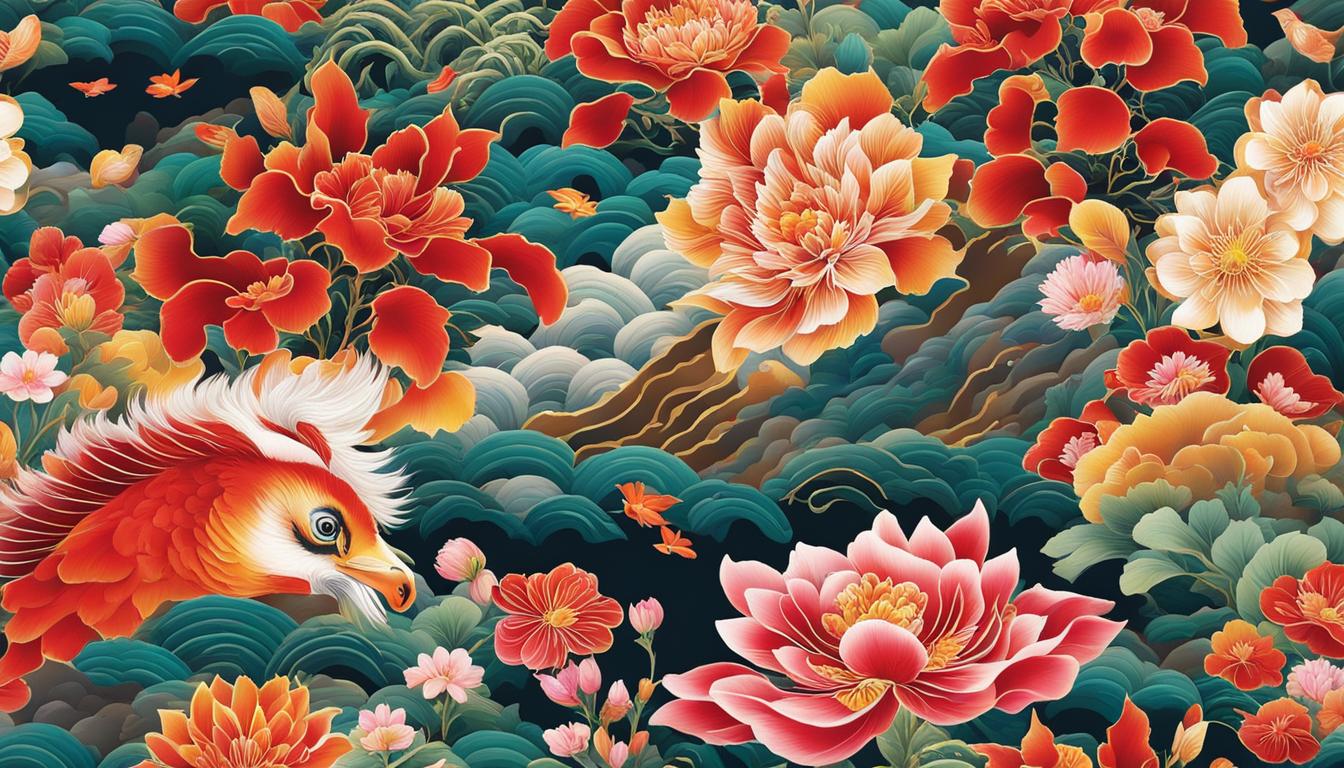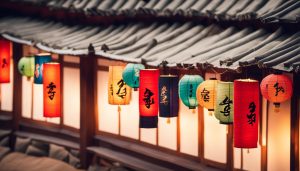In Korean culture, color symbolism holds a significant place when it comes to good luck and prosperity. Five colors, namely blue, red, white, black, and yellow, carry deep meaning and represent the five cardinal directions and elements of life. Traditional Korean teaching believed that incorporating these colors in various aspects of life is essential for a healthy and prosperous existence. From clothing to art, food to festivals, these colors shine brightly in Korean culture.
Contents
- 1 Korean Color Symbolism in Traditional Clothing and Art
- 2 Traditional Beliefs and Symbols of Good Luck in Korea
- 3 Conclusion
- 4 FAQ
- 4.1 What are the five colors of significance in Korean culture?
- 4.2 What do these five colors represent?
- 4.3 Where can these colors be seen in Korean culture?
- 4.4 What is the significance of these colors in Korean clothing?
- 4.5 How are these colors used in Korean cuisine?
- 4.6 What role do these colors play in Korean art and architecture?
- 4.7 What is the cultural significance behind these colors in Korean culture?
- 5 Source Links
Key Takeaways:
- The five colors – blue, red, white, black, and yellow – hold immense significance in Korean culture.
- These colors represent the five cardinal directions and elements of life.
- Korean traditional clothing, art, food, and architecture incorporate these colors.
- Colors in Korean cuisine are believed to bring balance and nutrition.
- The obangsaek colors hold ancient theories and symbolize various meanings in Korean culture.
Korean Color Symbolism in Traditional Clothing and Art
In Korean culture, the five colors of blue, red, white, black, and yellow hold great significance when it comes to symbolism and good luck. These colors are not only prominently featured in traditional clothing known as ‘Hanbok’ but also in Korean paintings and various other aspects of Korean culture. Additionally, green has also become commonly used alongside the original five colors.
The colors blue, red, white, black, and yellow are deeply rooted in Korean folklore and are associated with various traditional beliefs and symbols of good luck. In Korean traditional clothing, these colors represent the five cardinal directions and the elements of life. Adhering to these colors in Korean cooking was believed to ensure a healthy meal and maintain balance in life.
Table: The Symbolism of Obangsaek Colors in Korean Culture
| Color | Symbolism |
|---|---|
| Blue | New birth and clarity |
| Red | Creation and passion |
| White | Truth and purity |
| Black | Wisdom and darkness |
| Yellow/Gold | Brightness and prosperity |
The obangsaek colors are not only seen in clothing and food but also play a significant role in Korean art and architecture. Traditional paintings use these colors to add depth and symbolism, while architecture incorporates them in vibrant patterns known as dancheong. The obangsaek colors represent the dignity and authority of important structures, creating a sense of mystique.
Exploring the cultural significance of colors in Korea allows us to appreciate the deep-rooted traditions and symbolism that continue to influence Korean society today. From clothing to art, food, and architecture, the obangsaek colors embody the rich heritage and belief in good luck and prosperity that are integral to Korean culture.
Traditional Beliefs and Symbols of Good Luck in Korea
In Korean culture, the five colors of blue, red, white, black, and yellow hold deep cultural meaning and are associated with traditional beliefs and symbols of good luck. These colors trace their origins to the ancient Chinese theory of Yin and Yang, which emphasizes balance and harmony. Each color has its own significance and is used in various cultural practices, such as traditional ceremonies, hanbok designs, and even in the colors of food.
The color red, for instance, is believed to have the power to ward off evil spirits, while black symbolizes wisdom. White represents truth and purity, and yellow or gold signifies brightness and prosperity. These colors are not only visually appealing but also hold a significant place in the hearts of Koreans, as they are deeply intertwined with their cultural heritage.
The belief in the power of these colors extends beyond ceremonial practices and clothing. Korean food also incorporates the cultural significance of colors, with traditional dishes like bibimbap, kimbap, gujeolpan, and japchae following the obangsaek color spectrum. Eating a meal with all five colors was believed to provide a balanced and nutritious meal for the body’s vital organs, adding a deeper level of symbolism and cultural meaning to the dining experience.
Whether it’s the vibrant colors of traditional clothing, the symbolic use of colors in artwork, or the incorporation of colors in cuisine, the cultural meaning of colors in Korea showcases the deep-rooted traditions and beliefs that continue to shape and influence Korean society even today.

Korean culture is deeply influenced by the ancient theory of obangsaek, a set of five colors that hold great significance. Each color represents one of the cardinal directions and the five elements, and is believed to bring luck, balance, and prosperity to life. Let’s explore the cultural meaning of these colors and the traditional beliefs associated with them in Korean society.
The Five Colors and Their Symbolism
The five colors of obangsaek in Korean culture are red, black, blue, white, and yellow. Red symbolizes creation and passion, representing the South and fire. Black represents wisdom and darkness, symbolizing the North and water. Blue signifies new birth and clarity, representing the East and wood. White represents truth and purity, symbolizing the West and metal. Yellow or gold represents brightness and rays of sunlight, signifying the center and earth.
Traditional Beliefs and Practices
These obangsaek colors are deeply rooted in Korean folklore and are associated with various traditional beliefs and practices. For example, red is believed to ward off evil spirits, while black is associated with wisdom. White is considered a symbol of truth and purity, and yellow or gold is associated with brightness and prosperity. These colors are not only used in traditional ceremonies and rituals but also in hanbok designs, traditional paintings, and even in the colors of food.
Continuing Influence in Modern Korean Society
The cultural meaning of obangsaek colors continues to be valued and celebrated in modern Korean society. These colors are still prominently featured in Korean traditional clothing, art, food, and architecture. They not only add visual appeal but also convey deep-rooted traditions and symbolism. Exploring the ancient theory behind obangsaek in Korean culture provides insight into the rich heritage of the country and the enduring significance of these colors in shaping Korean identity.
Conclusion
In Korean culture, the five obangsaek colors hold tremendous cultural meaning and symbolize good luck. These colors, blue, red, white, black, and yellow, represent the five cardinal directions and the elements of life. Traditional Korean teachings emphasize the importance of these colors for a prosperous and balanced life. You can see the influence of these colors in various aspects of Korean culture, such as clothing, art, food, and architecture.
From the vibrant hues of traditional Hanbok clothing to the symbolic use of obangsaek in paintings and architectural elements like dancheong, the cultural significance of these colors is evident. In Korean cuisine, the obangsaek colors are incorporated into dishes to provide a balanced and nutritious meal. This attention to color adds depth and cultural meaning to the dining experience.
The belief in the power of these colors is deeply rooted in ancient Chinese philosophy, promoting balance and harmony. Each color carries its own significance, with red warding off evil spirits, black symbolizing wisdom, white representing purity, and yellow or gold signifying prosperity. These cultural beliefs continue to influence modern Korean society and showcase the rich heritage and traditions that shape Korean culture today.
Exploring the cultural meaning of colors in Korea allows us to appreciate the deep-rooted traditions and symbolism that are still celebrated. By understanding the significance of these colors, you can gain insight into Korean culture, its values, and its strong connection to the past. Whether it’s the vibrant hues of a Hanbok or the colorful patterns on a traditional building, the obangsaek colors continue to play an important role in Korean society, reminding us of the power of symbolism and tradition.
FAQ
What are the five colors of significance in Korean culture?
The five colors of significance in Korean culture are blue, red, white, black, and yellow.
What do these five colors represent?
These colors represent the five cardinal directions and the five elements of life.
Where can these colors be seen in Korean culture?
These colors can be seen in various aspects of Korean culture, including clothing, art, food, and festivals.
What is the significance of these colors in Korean clothing?
The five colors are prominently featured in Korean traditional clothing, known as ‘Hanbok’.
How are these colors used in Korean cuisine?
Traditional Korean dishes adhere to the obangsaek color spectrum, incorporating all five colors for a balanced and nutritious meal.
What role do these colors play in Korean art and architecture?
The obangsaek colors are used in traditional paintings and architecture, adding depth and symbolism to the artwork and structures.
What is the cultural significance behind these colors in Korean culture?
These colors are deeply rooted in Korean folklore and traditional beliefs, symbolizing various aspects of luck and prosperity.





